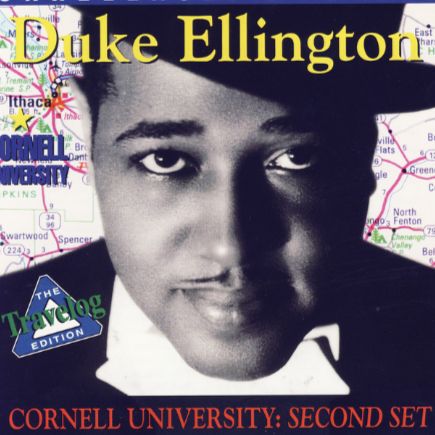How High the Moon: l’ascension d’un standard emblématique
Composée en 1940 par Morgan Lewis, sur des paroles de Nancy Hamilton, How High the Moon fait sa première apparition dans la revue de Broadway Two for the Show, interprétée par Alfred Drake et Frances Comstock. Dans ce spectacle au ton généralement léger, la chanson faisait figure d’exception, apportant une touche de gravité et de poésie.
Très vite, elle dépasse le cadre de la scène pour s’imposer comme l’un des standards les plus emblématiques du répertoire jazz. À travers ses harmonies souples et sa structure ouverte, How High the Moon incarne un tournant dans l’histoire du jazz. Composée à un moment où le genre amorce une nouvelle phase de diversification et d’expérimentation, elle devient un support privilégié pour l’improvisation, stimulant la créativité des musiciens.
Les paroles expriment un sentiment de manque et de désir, évoquant un amour lointain, presque irréel. Cette tension entre espoir et inaccessibilité reflète une thématique chère au jazz: celle de la quête, du rêve toujours à portée mais jamais saisi.
Webster et Ellington, l’art du souffle et de l’élévation
Lorsqu’en 1948, Duke Ellington choisit d’intégrer How High the Moon à ses concerts, ce standard populaire devient entre ses mains une matière vivante, sculptée par l’élégance orchestrale de son ensemble et magnifiée par la voix profonde du saxophone ténor de Ben Webster. Deux captations en témoignent: celle du 13 novembre au Carnegie Hall de New York et celle du 10 décembre à la Cornell University.
Ben Webster, l’un des grands stylistes du saxophone ténor, qui avait réintégré l’orchestre d’Ellington le mois précédent, insuffle à How High the Moon une dimension à la fois chaleureuse et méditative. Son timbre feutré, sa respiration ample et ses attaques douces font de son interprétation une leçon d’expressivité contenue.
L’orchestre, fidèle à son esthétique, tisse un écrin raffiné autour du soliste. Les cuivres et les bois dialoguent avec lui par touches impressionnistes, tout en maintenant une pulsation swing discrète. Ellington privilégie ici la transparence des textures, la fluidité des transitions, et surtout, l’écoute mutuelle.
Ces deux enregistrements, réalisés à quelques semaines d’intervalle, révèlent également une facette plus introspective du répertoire ellingtonien de l’après-guerre. Dans cette période de transition stylistique, où le bebop s’impose dans les clubs, Ellington et Webster rappellent avec dignité et profondeur la valeur de la ligne mélodique, du phrasé naturel, et de l’émotion directe.
How High the Moon: el ascenso de un estándar emblemático
Compuesta en 1940 por Morgan Lewis, con letra de Nancy Hamilton, How High the Moon apareció por primera vez en la revista de Broadway Two for the Show, interpretada por Alfred Drake y Frances Comstock. En un espectáculo de tono generalmente ligero, la canción destacaba por aportar una nota de gravedad y poesía.
Muy pronto, trascendió el ámbito teatral para imponerse como uno de los estándares más emblemáticos del repertorio jazzístico. Con sus armonías flexibles y su estructura abierta, How High the Moon marcó un punto de inflexión en la historia del jazz. Compuesta en un momento en que el género entraba en una nueva etapa de diversificación y experimentación, se convirtió en una plataforma ideal para la improvisación, estimulando la creatividad de los músicos.
La letra expresa un sentimiento de anhelo y deseo, evocando un amor lejano, casi irreal. Esta tensión entre esperanza e inaccesibilidad refleja un tema central del jazz: la búsqueda, el sueño que siempre parece cercano, pero nunca alcanzado.
Webster y Ellington, el arte del aliento y la elevación
Cuando en 1948 Duke Ellington decidió incluir How High the Moon en sus conciertos, este estándar popular se transformó en sus manos en una materia viva, esculpida por la elegancia orquestal de su conjunto y sublimada por la voz profunda del saxofón tenor de Ben Webster. Dos grabaciones dan testimonio de ello: la del 13 de noviembre en el Carnegie Hall de Nueva York y la del 10 de diciembre en la Universidad de Cornell.
Ben Webster, uno de los grandes estilistas del saxofón tenor, que había regresado a la orquesta de Ellington el mes anterior, confiere a How High the Moon una dimensión cálida y meditativa. Su timbre aterciopelado, su respiración amplia y sus ataques suaves hacen de su interpretación una lección de expresividad contenida.
La orquesta, fiel a su estética, teje un marco refinado alrededor del solista. Los metales y las maderas dialogan con él mediante toques impresionistas, manteniendo una pulsación swing discreta. Ellington privilegia aquí la transparencia de las texturas, la fluidez de las transiciones y, sobre todo, la escucha mutua.
Estas dos grabaciones, realizadas con pocas semanas de diferencia, revelan también una faceta más introspectiva del repertorio ellingtoniano de la posguerra. En una época de transición estilística, cuando el bebop comenzaba a imponerse en los clubes, Ellington y Webster recuerdan con dignidad y profundidad el valor de la línea melódica, del fraseo natural y de la emoción directa.
How High the Moon: l’ascesa di uno standard emblematico
Composta nel 1940 da Morgan Lewis, con testi di Nancy Hamilton, How High the Moon debutta nella rivista di Broadway Two for the Show, interpretata da Alfred Drake e Frances Comstock. In uno spettacolo dal tono perlopiù leggero, la canzone si distingue per una nota di gravità e poesia.
Ben presto, esce dai confini del teatro per affermarsi come uno degli standard più iconici del repertorio jazz. Grazie alle sue armonie flessibili e alla struttura aperta, How High the Moon rappresenta una svolta nella storia del jazz. Composta in un periodo di grande fermento creativo, quando il genere si avviava verso una fase di diversificazione e sperimentazione, divenne uno strumento privilegiato per l’improvvisazione, stimolando la fantasia dei musicisti.
Il testo esprime un sentimento di mancanza e desiderio, evocando un amore lontano, quasi irreale. Questa tensione tra speranza e inaccessibilità riflette un tema caro al jazz: quello della ricerca, del sogno sempre vicino eppure mai afferrato.
Webster ed Ellington, l’arte del respiro e dell’elevazione
Quando nel 1948 Duke Ellington decise di inserire How High the Moon nei suoi concerti, questo celebre standard assunse una nuova vitalità, scolpita dall’eleganza orchestrale del suo ensemble e nobilitata dalla voce profonda del sax tenore di Ben Webster. Ne rimangono due testimonianze: quella del 13 novembre alla Carnegie Hall di New York e quella del 10 dicembre alla Cornell University.
Ben Webster, tra i grandi stilisti del sax tenore, rientrato nell’orchestra di Ellington il mese precedente, dona a How High the Moon una dimensione calda e riflessiva. Il suo timbro ovattato, il respiro ampio e gli attacchi morbidi rendono la sua interpretazione una lezione di espressività contenuta.
L’orchestra, fedele alla sua estetica, costruisce attorno al solista un’elegante cornice sonora. Gli ottoni e i legni dialogano con lui con tocchi impressionistici, mantenendo una pulsazione swing discreta. Ellington privilegia qui la trasparenza delle trame, la fluidità delle transizioni e, soprattutto, l’ascolto reciproco.
Queste due registrazioni, realizzate a poche settimane di distanza, rivelano anche un lato più introspettivo del repertorio ellingtoniano del dopoguerra. In un’epoca di transizione stilistica, in cui il bebop dominava i club, Ellington e Webster ricordano con dignità e profondità il valore della linea melodica, del fraseggio naturale e dell’emozione diretta.
How High the Moon: the rise of an iconic standard
Composed in 1940 by Morgan Lewis, with lyrics by Nancy Hamilton, How High the Moon made its debut in the Broadway revue Two for the Show, performed by Alfred Drake and Frances Comstock. In an otherwise lighthearted production, the song stood out for its poetic depth and emotional gravity.
It quickly moved beyond the stage to become one of the most iconic standards in the jazz repertoire. With its flexible harmonies and open structure, How High the Moon signaled a turning point in jazz history. Written at a time when the genre was entering a new phase of diversification and experimentation, it became a favored platform for improvisation, encouraging boundless creativity among musicians.
The lyrics express a sense of longing and desire, evoking a distant, almost unattainable love. This tension between hope and inaccessibility reflects a core theme in jazz: the pursuit of something just out of reach, a dream always near but never fully grasped.
Webster and Ellington, the art of breath and elevation
When Duke Ellington chose to include How High the Moon in his concerts in 1948, this popular standard became a living form in his hands—shaped by the orchestral elegance of his ensemble and magnified by the deep tenor voice of Ben Webster. Two live recordings capture the moment: one from November 13 at New York’s Carnegie Hall, and another from December 10 at Cornell University.
Ben Webster, one of the great tenor saxophone stylists, who had rejoined Ellington’s orchestra the previous month, brings to How High the Moon a sound that is both warm and contemplative. His velvety tone, expansive breath, and gentle attacks make his interpretation a masterclass in restrained expressiveness.
The orchestra, true to its aesthetic, weaves a refined sonic fabric around the soloist. Brass and woodwinds engage in impressionistic exchanges, all while maintaining a discreet swing pulse. Ellington emphasizes transparency of texture, fluid transitions, and above all, mutual listening.
These two recordings, made just weeks apart, also reveal a more introspective side of Ellington’s postwar repertoire. In an era of stylistic transition, as bebop gained prominence in jazz clubs, Ellington and Webster offer a poignant reminder of the enduring power of melodic line, natural phrasing, and direct emotional connection.


